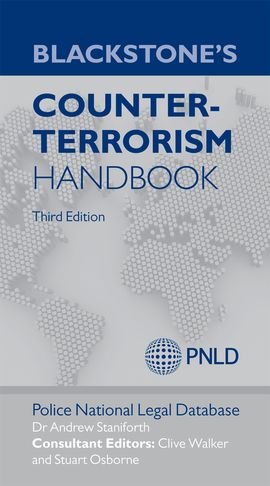
- Title: Blackstone's Counter-Terrorism Handbook (Third Edition)
- Authors: Andrew Staniforth, North East Counter Terrorism Unit, West Yorkshire Police and Police National Legal Database (PNLD)
- Editors: Clive Walker; Stuart Osborne
- Publisher: Oxford University Press
- ISBN: 978-0-199-65809-1
- Webpage: http://ukcatalogue.oup.com/product/9780199658091.do
- Date of Publication: July 2013
Designed specifically for all police officers and their counter terrorism training needs
Draws together anti-terrorism legislation, practical counter-terrorism information, and strategies in one volume
Clearly lays out all anti-terror powers and provisions with points to prove, powers of arrest, related cases and practical considerations
Covers the CONTEST 3 Counter-Terrorism strategy and National Security Strategy, and includes PACE Code H and the Codes of Practice under the Terrorism Act 2000
Written and endorsed by the Police National Legal Database (PNLD) – the officially endorsed online legal information service for police forces in England and Wales
Accessible and portable, this Handbook provides all counter-terrorism practitioners with an authoritative, operational guide to anti-terrorism legislation. It also contains important contextual chapters on the counter-terrorism operational framework, the national structures and strategies, and the role and functions of key agencies.
The third edition includes coverage of the Government’s CONTEST Strategy, Cyber Security Strategy, National Security Strategy and the national response to terrorist emergencies. It also presents new case studies on counter-terrorism investigations, guidance on the Government Protective Marking Scheme, and practical scenarios and checklists to illustrate the operational application of anti-terror laws. The legislative section, brought fully up to date by the highly regarded Police National Legal Database (PNLD), focuses upon terrorist offences, police powers and procedures. These provisions are accompanied by explanatory notes, related case law, and points to prove, ensuring clear and quick translation of complex powers for the practitioner.

